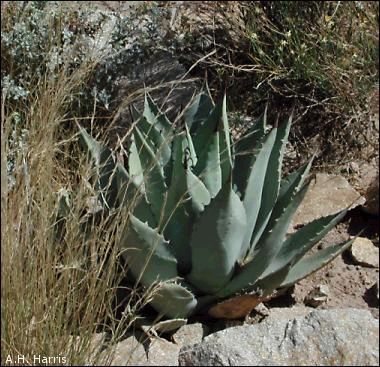
Agaves are widespread in the arid regions of North America. In much of the Chihuahuan Desert, depressions in the ground bear silent witness to the use of these plants in years past. Agaves store up food for many years before flowering, though far short of the century often ascribed. Some of this stored energy, if all goes well, is used to send up a flowering stalk. In many species this grows far taller than a man within a few weeks. The remaining energy goes to flowering and setting numerous seeds. In most species, the plant then dies, having exhausted itself in reproduction.
Humans often short-circuited the life cycle. Most of the stored sugars
and starches are in the massive base, the so-called cabeza—Spanish for head—which in
some may weigh up to 70 pounds. The leaves were hacked off, and the cabeza then was
roasted in pits. This was an important food source for Southwestern Native Americans—so
much so, that the Mescalero Apache take their name from a Spanish name for the
plant—mezcal.
![]()
Contributor: Arthur H. Harris, Laboratory for Environmental Biology, Centennial Museum, University of Texas at El Paso.
Desert Diary is a joint production of the Centennial Museum and KTEP National Public Radio at the University of Texas at El Paso.

Agave neomexicana, Chihuahuan Desert Gardens. Photograph by A.H. Harris.
The Agave Page from Succulent-Page.